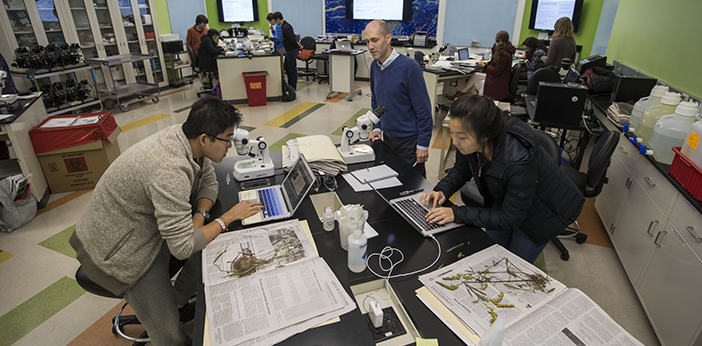Brown’s Herbarium is digitizing tens of thousands of plants preserved over two centuries.
Behind a zigzagging glass wall that faces into the main floor hallway of Brown’s BioMed Center, Dan Davis ’19 spent a recent Friday morning bringing precious treasures of natural history into the digital age. At the Brown University Herbarium, Davis—a dual concentrator in biology and music—has scanned thousands of pressed and dried plant samples into the facility’s rapidly growing public archive.
He places each sample in a brightly lit box that in another existence might house items being photographed for sale on eBay. A camera mounted above with the lens pointing downward snaps a perfect, high-resolution photo. As the image appears on a linked computer, Davis adds metadata to the database including whatever description appears on the label—what the plant is, where it was found, by whom, and when.
The samples date back as far as the 1820s. Davis says he often reflects on the history of the eras he encounters.
“You’re handling plants that existed during Abraham Lincoln’s presidency and prior to the Civil War,” he says. “These are relics of that history. We have some that are from the first explorations of the Colorado River.”
In many ways, the Herbarium collection brings history not exactly to life, but to the life sciences. Collections manager Tim Whitfeld, PhD, an assistant research professor of ecology and evolutionary biology, says that now that the entire North American collection of more than 57,000 items has been digitized, the stage is set for a new generation of ecological studies. And with the help of a new cadre of students in Whitfeld’s plant collection and identification course every fall semester, the trove continues to grow.
Whitfeld isn’t sure precisely how big the collection is, but it could be as many as 90,000 samples. Davis is working on scanning in some of the 20,000 or so plant samples from the rest of the world. There are also more than 15,000 samples of fungi, algae, mosses, and lichens.
Brown University botanists acquired the vast majority of the collection bit by bit over two centuries. In 2011, former faculty member Erika Edwards, PhD, led an effort to move it from a cramped basement in the Arnold Lab to its state-of-the-art facility in the BioMed Center with support from the Division of Biology and Medicine. Since then, Whitfeld, curatorial assistant Martha Cooper, PhD, and about a score of undergraduates like Davis have been organizing and digitizing it, with funding from the National Science Foundation, for the public good.
Read the full story here.




